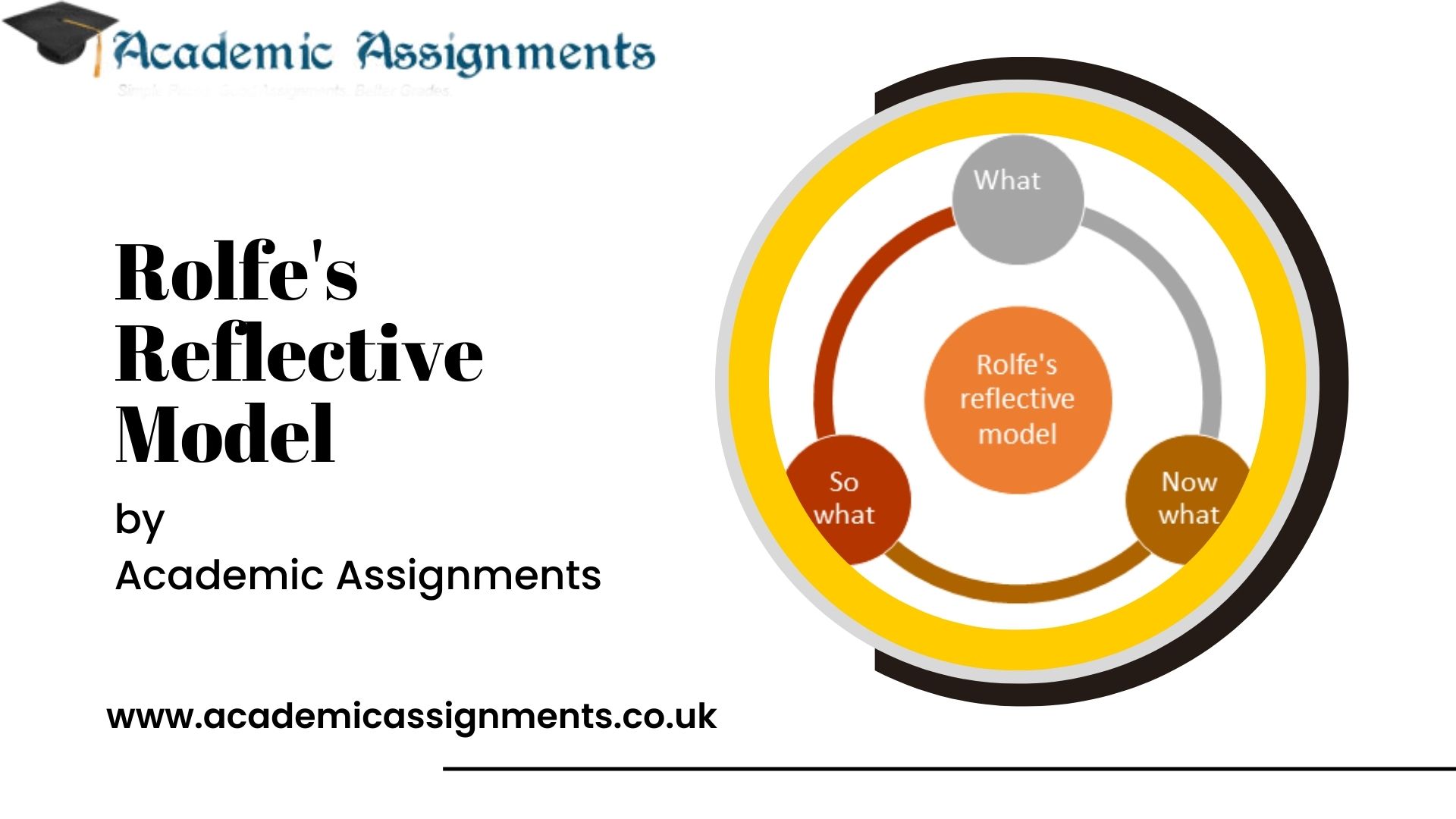Rolfe’s Reflective Model by Academic Assignments
Concept of Rolfe’s Reflective Model
One of the simplest forms of the reflective model is Rolfe’s reflective model, which relies only on three questions. These are ‘why’, ‘so what’ and ‘ now what. Self-reflection is regarded as an important key that helps in unlocking career-smart potential. Professor Gary Rolfe and his colleagues use this reflective model as a framework of self-reflection in the book ” Framework for Reflective Practice”. The interrogative expression ‘what’ details a particular situation, and after this, it focuses on the achievements, and then it focuses on the consequences, feelings, achievements, responses and other problems (Patel and Metersky, 2022). The next interrogative expression is ‘what’, which discusses what has been learnt about oneself, models, cultures, relationships, attitudes, actions, understanding, thoughts and any improvements.
After this comes the next interrogative expression, “now what”, which helps identify what needs to be done in the future that will help to develop the future outcomes and thus contribute to the development of learning of the individual.
Rolfe’s reflective cycle is regarded as the epitome of simplicity and straightforwardness. Initially, this model was developed for nursing and care education. However, its application has extended to broader areas (Rolfe and Freshwater, 2020). The model is cyclic, and it always indicates continuity. The dynamics in the approach or behaviour are generated from the reflective thought, which is later analysed.

Figure: Rolfe’s reflective model
(Source: Self-developed)
The Rolfe reflective model’s main advantages are mainly clarity and simplicity. This tool is useful and accessible to the user, and thus it can produce meaningful results. Rolfe’s reflective model is similar to Driscoll’s model of reflection.
Explanation of the there stages of Rolfe’s Reflective Model
Stage 1: What
This phase is referred to as the descriptive stage of Rolfe’s reflective model, and it mainly focuses on analysing a solution. Moreover, this stage of the model enables the readers to understand and explain the context of a situation (Mulvogue et al. 2019). This stage can be elaborated by conjuring the following:
- What happened
In this stage, the context of the situation is explained to the readers, and this is done by giving factual information about the situation that has to be reflected upon.
- What has been felt
In this stage, the overall feeling that is experienced in the situation is highlighted.
- What has to be done
When answering the question, it is necessary to highlight the reader’s contribution to the situation.
- What were the expected consequences?
In this stage, mainly the outcomes or the consequences are focused upon that is expected from the incident that is being focused upon.
- What were the outcomes?
After the expectations of the outcomes are explained, it is required to present the outcomes of the actions taken in the situation.
Stage 2: So what
This second stage mainly encompasses an analysis phase which concerns determining the consequences, learnings, or actions (Patel and Metersky, 2022). This can be further comprehended by looking at the following sections.
- What is learnt?
The learnings throughout the situation are highlighted, which is being reflected upon.
- What is going on in the mind?
When it comes o answering these questions, the thoughts are highlighted what is going on in the mind during the events.
- On what basis are the actions being taken?
This details the actions that are taken based on the situation.
- What is the new understanding?
In this section, the new learning highlighted that is gained from the situation and the methods in which learnings are perceived.
Stage 3: Now what?
The last stage of the reflective model is the ” now what” interrogative stage. This stage details the actions that must be taken to develop future outcomes. This stage comprises the considerations of the skills that will be useful in developing future actions.
Techniques used to deal with similar actions in future
In this stage, the ways will be highlighted that are required to deal with the situations in future. This model is mainly needed for reflective writing in nursing and healthcare. This is because this model enables the practitioners and the learners in the healthcare settings and nursing, and this is needed to develop the quality of healthcare.
In the modern healthcare system, Rolfe’s reflective model helps empower healthcare professionals to analyse the patient’s care and highlight their practices. The model proposes a structured process to evaluate the action or the experience, encouraging the practitioner to develop a deeper understanding of their own experience. Also, this model is effectively used in the modem healthcare system to support, evaluate and improve patient safety, care delivery and education (Mulvogue et al. 2019). Over the years, the effectiveness of healthcare service delivery has improved due to the application of Rolfe’s reflective model.
In addition, healthcare providers are persistently learning and adopting the available new procedures and thus, reflective practices have become an integral skill for healthcare workers. Daily use of reflective practices by healthcare practitioners can identify the problem areas in care delivery. It also helps make adjustments and ensure that the patients receive the best care.
Example of a Rolfe Reflective model
Case assessment: The reflective assessment will discuss the experience undergone by a medical practitioner while giving medication to a patient who is suffering from depression and anxiety. This reflective model highlights the challenges the nurse encounters while diagnosing the patient in the hospital.
Stage 1: What
A patient diagnosed with anxiety and depression is admitted to the hospital. When the patient approached me, I prescribed citalopram and sertraline to relieve the anxiety and the depression. However, a doctor came on round and advised me that the combination of both medicines can affect the serotonin of the patient, which can lead to a life-threatening situation. In a state of horror, I filled up the incident form and also informed the family members about the incident that had taken place. Fortunately, the patient did not suffer the effect of the medicine as worried. To avoid any further complications, my senior doctor also took precautions. Besides this, I was also fortunate that my senior doctor did not file a complaint against me and effectively handled the situation.
Stage 2: So what?
The entire situation I have gone through has helped me identify the significance of giving the right kind of drugs to patients. Besides this, I have learnt to provide the right kind of drugs to the patients and also got concerned about the dosage needed to be given. In addition, I also learned that there is a need for proper consultation with the senior doctor before giving the right kind of medicines to the patients. I also consulted the Health and Social Care Act 208 to assess the importance of patient safety and avoiding medical errors. The best way to avoid medical errors is to consult a senior doctor. I also relieved myself knowing that the patient survived the overdosage of medicines, which happened with the senior doctors’ resilient knowledge and health management skills. By undergoing the entire situation, I understood the drugs suitable for treating anxiety and depression. The knowledge I have acquired will help me encounter such situations in the later years of my life.
Stage 3: Now what
From the above experience, I have acquired knowledge regarding the dosage and the right kind of drugs to be given to patients. After getting indulged in a medical error, I have decided to be cautious while prescribing the drugs. In addition, I have also decided to refer to the medical book if necessary while prescribing medicines and preventing medical errors. Also, I will communicate properly with the senior nursing staff, doctors and supervisors to deliver improved quality health services to the patients.
Advantages and Disadvantages of Rolfe’s Reflective Model
The advantages of the Rolfe reflective model are:
- This model is simple to use
- It is easy and simple to understand as it provides guidance related to the contents of each interrogative stage.
- Compared to Borton’s model, Rolfe’s reflective model is much more comprehensive.
- This model was developed considering the benefits of the healthcare sector and nursing—for instance, the contemplation of what happened from the client and the perspective of various others.
- This model imbibes the different elements of the intangible experience, including feelings.
- Both the novices and the professional practitioners of the healthcare sectors have increased the competence of this model.
The disadvantages of the Rolfe reflective model are stated below:
- This model is much more complex than the other models, such as Borton’s.
- It narrowly focuses on nursing, which lessens its application in various other fields.
- The second stage’s analysis is comprehensive, so it depends on theoretical knowledge.
- To support and aid learning, this model needs persistent use.
References
- Patel, K.M. and Metersky, K., 2022. Reflective practice in nursing: A concept analysis. International journal of nursing knowledge, 33(3), pp.180-187.
- Rolfe, G. and Freshwater, D., 2020. Critical reflection in practice: generating knowledge for care. Bloomsbury Publishing.
- Mulvogue, J., Ryan, C. and Cesare, P., 2019. Nurse simulation facilitator experiences learning open dialogue techniques to encourage self-reflection in debriefing. Nurse Education Today, 79, pp.142-146.
FAQs
- Define Rolfe’s Reflective model
Ans: The Rolfe reflective model was developed by Professor Gary Rolfe, whose main aim is to support the practitioners in the healthcare sector so that they can reflect on their practices, feelings and experiences accordingly. - What are the three interrogative stages in the Rolfe Reflective model?
Ans: The three stages in the Rolfe reflective model are:
What-This stage identifies the issue, or is it focused on describing the event? In addition, it also defines the awareness of the self.
So what- This stage helps analyse the situation being reflected upon. It initiates to make the evaluations of the situations that are being addressed.
Now what- This stage focuses on synthesising the insights and the information. - State two pros of the Rolfe reflective model.
Ans: a.It is accessible and useful to the user so that it can produce meaningful results.
b. It is simple and maintains clarity. - State two cons of the Rolfe reflective model.
Ans: a.This model is much more complex than Borton’s model
b. This model needs constant use so that it can support learning. - In which field the Rolf reflective model is mainly used?
Ans: The Rolfe reflective model is mainly used in nursing and healthcare. It helps in empowering healthcare professionals so that they can analyse the care of the patient and highlight their practices.
Author Bio: Academic Assignments is a reputable assignment writing company specializing in offering comprehensive assistance to students in their academic pursuits. With our expert team of writers, we ensure top-notch essay writing service that meet the highest standards of quality and excellence. Trust us for reliable assignment help and experience the difference in your academic journey.

 Blogs
Blogs





